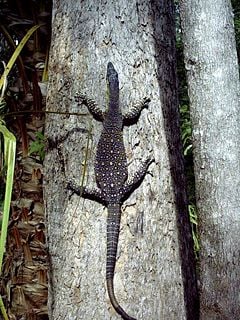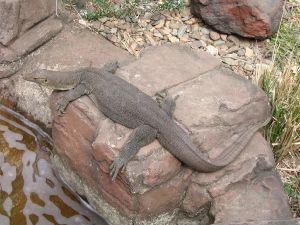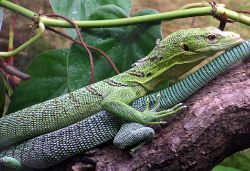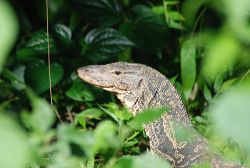Difference between revisions of "Monitor lizard" - New World Encyclopedia
Rick Swarts (talk | contribs) |
Rick Swarts (talk | contribs) |
||
| Line 19: | Line 19: | ||
In [[Tamil language|Tamil]] and [[Malayalam language|Malayalam]] monitor lizards are known as "Udumbu" and in [[Australia]], they are known as [[goanna]]s (See main article). In [[Kannada language|Kannada]] monitor lizards are known as "Uda". In [[Sinhalese language|Sinhalese]] the moniter lizard is known as "Kabaragoya". | In [[Tamil language|Tamil]] and [[Malayalam language|Malayalam]] monitor lizards are known as "Udumbu" and in [[Australia]], they are known as [[goanna]]s (See main article). In [[Kannada language|Kannada]] monitor lizards are known as "Uda". In [[Sinhalese language|Sinhalese]] the moniter lizard is known as "Kabaragoya". | ||
| + | |||
| + | |||
| + | '''''Lanthanotus borneensis''''' (earless monitor) <sup id="fn_(1)_back">[[#fn (1)|(1)]]</sup> is a semi-aquatic, brown lizard from Borneo. — some consider a subfamily | ||
==Distribution== | ==Distribution== | ||
Revision as of 13:08, 5 June 2008
| Monitor lizards | ||||||||||||||||
|---|---|---|---|---|---|---|---|---|---|---|---|---|---|---|---|---|
 An Australian lace monitor
(Varanus varius) on a tree. | ||||||||||||||||
| Scientific classification | ||||||||||||||||
| ||||||||||||||||
|
Category:Monitor lizards |
Monitor lizards are the family Varanidae, a group of carnivorous lizards which includes the largest living lizard, the Komodo dragon. Varanidae is monotypic, containing only the genus Varanus.
In Tamil and Malayalam monitor lizards are known as "Udumbu" and in Australia, they are known as goannas (See main article). In Kannada monitor lizards are known as "Uda". In Sinhalese the moniter lizard is known as "Kabaragoya".
Lanthanotus borneensis (earless monitor) (1) is a semi-aquatic, brown lizard from Borneo. — some consider a subfamily
Distribution
The various species of Varanus cover a vast area, occurring through Africa, the Asian subcontinent from India and Sri Lanka to China, down Southeast Asia to Indonesia, the Philippines, New Guinea, Australia and islands of the Indian Ocean and South China Sea.
Evolutionary overview
Monitor lizards differ greatly from other lizards in several ways, possessing a relatively high metabolic rate for reptiles and several sensory adaptations that benefit the hunting of live prey. Recent research indicates that the varanid lizards, including the Komodo dragon, may have very weak venom.[1] The discovery of venom in Monitor Lizards, as well as in agamid Lizards, led to the Toxicofera hypothesis: that all venomous reptiles share a common venomous ancestor. Some monitor lizards are apparently capable of parthenogenesis.[2] Almost all Monitor lizards are carnivorous.
Origin of the name
The genus name, "Varanus" is derived from the Arabic word waral ورل, which is translated to English as "monitor". It has been suggested that the occasional habit of varanids to stand on their two hind legs and to appear to "monitor" their surroundings led to the original Arabic name.[3] According to legend, these lizards were supposed to warn people that crocodiles were nearby.[4]
Intelligence
Varanid lizards are very intelligent, and some species can even count.[5] Careful studies feeding V. albigularis at the San Diego Zoo varying numbers of snails showed that they can distinguish numbers up to six.[5][4][6] V. niloticus have been observed to cooperate when foraging.[7] One varanid lures the female crocodile away from her nest while the other opens the nest to feed on the eggs.[7] The decoy then returns to also feed on the eggs.[7][4] Komodo dragons, V. komodoensis, at the Smithsonian National Zoological Park in Washington, D.C., recognize their keepers and seem to have distinct personalities.[4]
Monitor lizards as pets
Monitor lizards have become a staple in the reptile pet trade. The most commonly kept monitors are the savannah monitor, white throated monitor, and Acklin's monitor, due to their relatively small size and ease of domestication. Nile monitors, water monitors, mangrove monitors, and papau monitors have also been kept in captivity. Like all reptiles that are kept as pets, monitors need hiding places, and an appropriate substrate (bedding). Monitors also need a large water dish in which they can soak their entire body. In the wild, monitors will eat anything they can overpower, but crickets, superworms, and the occasional rodent make up most of the captive monitors' diet. Boiled eggs, silkworms, earthworms, and feeder fish can also be fed to monitors. Monitor lizards have been compared to reptilian cats - independent animals with different personalities. However, due to their predatory nature and large size some monitors can be dangerous to keep as pets. Adult nile monitors can reach seven feet in length, and are stronger than an alligator of equal weight.
The Bengal Monitor Lizards
The Bengal Monitor lizard, also known as the Common Indian Monitor lizard, is not uncommon in Asia and Africa. It is widely said to have been used to scale the fort of Kondana in Pune, India, by Tanaji Malusare, a general in the army of the Maratha ruler Shivaji. The skin of this lizard has traditionally been utilized in making the Kanjira, a South Indian classical percussion instrument. Now however, it is not in vogue owing to the increased awareness to the dwindling population of the lizard. The lizard evokes mixed responses from the people across the world. It is considered a delicacy in Sri Lanka. It is killed for sport in North Eastern India. It is revered in Maharashtra, India where an entire clan of people use "Ghorpade" as their surname after "Ghorpad", the local name for the Bengal Monitor lizard [8].
Classification
Genus Varanus
- Spiny-tailed goanna, Varanus acanthurus acanthurus
- Common Ridge-tailed Monitor, Varanus acanthurus brachyurus
- Island Ridge-tailed Monitor, Varanus acanthurus insulanicus
- Rock Monitor, Varanus albigularis
- White-throated Monitor, Varanus albigularis albigularis
- Angola White-throated Monitor, Varanus albigularis angolensis
- Black-throated Monitor, Varanus albigularis ionidesi
- Peacock Monitor, Varanus auffenbergi
- Northern Ridge-tailed Goanna, Varanus baritji
- Black tree monitor, Varanus beccarii
- Bengal monitor, Varanus bengalensis
- Golden-spotted Tree Monitor, Varanus boehmei
- Louisiade Tree Monitor, Varanus bogerti
- Short-tailed monitor, Varanus brevicauda
- Pilbara Goanna Varanus bushi
- Turquois Monitor, Varanus caerulivirens
- Stripe-tailed Goanna, Varanus caudolineatus
- Ceram Mangrove Monitor, Varanus cerambonensis
- Blue-tailed Monitor, Varanus doreanus
- Dumeril's Monitor, Varanus dumerilii
- Desert Pygmy Monitor, Varanus eremius
- Savannah monitor, Varanus exanthematicus
- Finsch's Monitor, Varanus finschi
- Yellow Mangrove Monitor, Varanus flavescens
- Perentie, Varanus giganteus
- Pygmy Mulga Goanna, Varanus gilleni
- Kimberley Rock Monitor, Varanus glauerti
- Black-palmed Rock Monitor, Varanus glebopalma
- Sand goanna, Varanus gouldii
- Horn's Monitor, Varanus gouldii horni
- Yellow-spotted Monitor, Varanus gouldii rubidus
- Desert Monitor, Varanus griseus
- Western Desert Monitor, Varanus griseus griseus
- Eastern Desert Monitor, Varanus griseus caspius
- Thar Desert Monitor, Varanus griseus koniecznyi
- Mangrove Monitor, Varanus indicus
- Peach Throat Monitor, Varanus jobiensis
- Hakoi, Varanus juxtindicus
- Canopy Goanna, Varanus keithhornei
- King's Goanna, Varanus kingorum
- Komodo Dragon, Varanus komodoensis
- Kordo Tree Monitor, Varanus kordensis
- Panay Monitor, Varanus mabitang
- Blue-spotted Tree Monitor, Varanus macraei
- Quince Monitor, Varanus melinus
- Mertens' Water Monitor, Varanus mertensi
- Mitchell's Water Monitor, Varanus mitchelli
- Clouded Monitor, Varanus nebulosus
- Nile monitor, Varanus niloticus
- Gray's monitor, Varanus olivaceus
- Ornate Monitor, Varanus ornatus
- Argus monitor, Varanus panoptes panoptes
- Varanus panoptes horni
- Varanus panoptes rubidus
- Pilbara Rock Monitor, Varanus pilbarensis
- Emerald Tree Monitor, Varanus prasinus
- Blunt-spined Goanna, Varanus primordius
- Megalania, Varanus prisca (extinct)
- Varanus rainerguentheri
- Reisinger's Tree Monitor, Varanus reisingeri
- Rosenberg's Goanna or Heath Monitor, Varanus rosenbergi
- Black Roughneck Monitor, Varanus rudicollis
- Crocodile monitor, Varanus salvadorii
- Water Monitor, Varanus salvator
- Asian Water Monitor, Varanus salvator salvator
- Andaman Islands Water Monitor, Varanus salvator andamanensis
- Two-striped Water Monitor, Varanus salvator bivittatus
- Cuming's Water Monitor, Varanus salvator cumingi
- Black Water Monitor, Varanus salvator komaini
- Marbled Water Monitor, Varanus salvator marmoratus
- Negros Water Monitor, Varanus salvator nuchalis
- Togian Water Monitor, Varanus salvator togianus
- Spotted Tree Goanna, Varanus scalaris
- Mangrove pygmy goanna, Varanus semiremex
- Spencer's Goanna, Varanus spenceri
- St. Isabel Mangrove Monitor, Varanus spinulosus
- Storr's Goanna, Varanus storri
- Eastern Storr's Goanna, Varanus storri storri
- Western Storr's Monitor, Varanus storri ocreatus
- Rossel Island Tree Monitor, Varanus telenesetes
- Timor Tree Monitor, Varanus timorensis
- Black-headed Monitor, Varanus tristis
- Freckled Monitor, Varanus tristis orientalis
- Lace Monitor, Varanus varius
- Yemen Monitor, Varanus yemenensis
- Tri-colored Monitor, Varanus yuwonoi
- Varanus zugorum
ReferencesISBN links support NWE through referral fees
- ↑ Fry, B.G; Vidal, N; Norman J.A.; Vonk F.J.; Scheib, H.; Ramjan S.F.R; Kuruppu S.; Fung, K.; Hedges, B.; Richardson M.K.; Hodgson, W.C.; Ignjatovic, V.; Summerhays, R. and Kochva, E. 2006. Early evolution of the venom system in lizards and snakes. Nature. 439, 584-588. Summary
- ↑ Smith, Kerri. Dragon virgin births startle zoo keepers. Nature. Retrieved 2006-12-20.
- ↑ Pianka, E.R.; King, D.R. and King, R.A. 2004. Varanoid Lizards of the World. Indiana University Press.
- ↑ 4.0 4.1 4.2 4.3 Pianka, Eric R. Varinidae [1]
- ↑ 5.0 5.1 King, Dennis & Green, Brian. 1999. Goannas: The Biology of Varanid Lizards. University of New South Wales Press. ISBN 0-86840-456-X, p. 43.
- ↑ The Weekend Australian. July 24-25, 1999, p. 12.
- ↑ 7.0 7.1 7.2 King, Dennis & Green, Brian. 1999. Goannas: The Biology of Varanid Lizards. University of New South Wales Press. ISBN 0-86840-456-X, p. 43.
- ↑ Little Book of Monitor Lizards, Daniel Bennett, Viper Press, 1995
- Ast, J. C. 2003. Varanidae Animal Diversity Web. Retrieved June 5, 2008.
- Integrated Taxonomic Information System (ITIS). 2006a. Varanidae ITIS Taxonomic Serial No.: 174114. Retrieved June 5, 2008.
- Integrated Taxonomic Information System (ITIS). 2006b. Varanus Merrem, 1820 ITIS Taxonomic Serial No.: 174115. Retrieved June 5, 2008.
External links
Credits
New World Encyclopedia writers and editors rewrote and completed the Wikipedia article in accordance with New World Encyclopedia standards. This article abides by terms of the Creative Commons CC-by-sa 3.0 License (CC-by-sa), which may be used and disseminated with proper attribution. Credit is due under the terms of this license that can reference both the New World Encyclopedia contributors and the selfless volunteer contributors of the Wikimedia Foundation. To cite this article click here for a list of acceptable citing formats.The history of earlier contributions by wikipedians is accessible to researchers here:
The history of this article since it was imported to New World Encyclopedia:
Note: Some restrictions may apply to use of individual images which are separately licensed.



